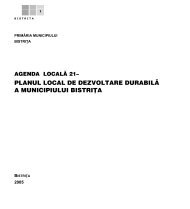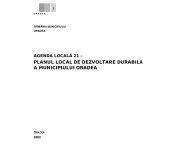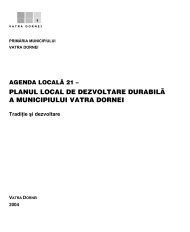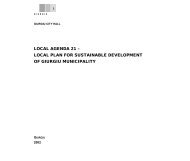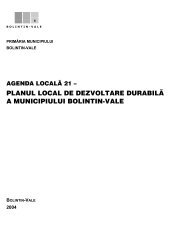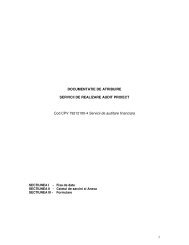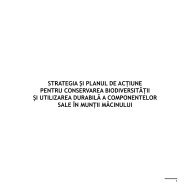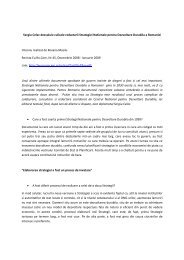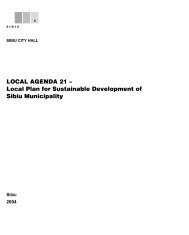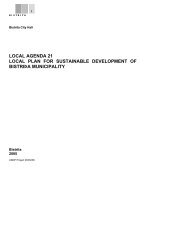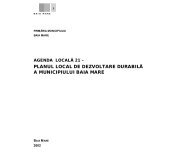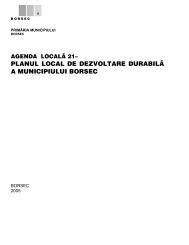English Version - United Nations Development Programme Romania
English Version - United Nations Development Programme Romania
English Version - United Nations Development Programme Romania
Create successful ePaper yourself
Turn your PDF publications into a flip-book with our unique Google optimized e-Paper software.
Interior rivers 40 25** 13<br />
The Danube 85* 30 10<br />
Subterranean water 9 6 3<br />
TOTAL 134 61 26<br />
* - represents 1/2 of the annual medium stock streamed on the Danube in the Bazias sector;<br />
** - collects cca. 5 billion m 3 of secure resources under normal circumstances<br />
Source: “<strong>Romania</strong>n Waters” National Company, 1999.<br />
On the average, the Q min /Q max ratio is 1/200, and on certain watercourses it can become 1/1000 or<br />
even 1/2000. The Danube, the second largest river in Europe, with 2850 km of length, of which 1075 km<br />
are in our country's territory (37.7%) has an average of 170 billion cubic meters of water on entering the<br />
country. Its international character presupposes certain limits in the exploitation of its resources and, for<br />
this reason, only half of the average volume that goes through the Bazias section is considered a resource.<br />
The subterranean water resources are in medium and deep subsoil water bearing strata. Set in<br />
relation to the country’s population, it can be said that there is more supply than demand, as the average<br />
annual water consumption in <strong>Romania</strong> is 2705 cubic meters per capita as compared to the European<br />
average figure of 4000 cubic meters per capita.<br />
In order to create a discharge regulation, 1900 large lakes were made, outfitted with all the<br />
necessary equipment for the complex use of water, collecting a volume totalling 13 billion cubic meters in<br />
1996. At the same time, over 2000 km of canals and derivations were built to transfer large quantities<br />
from basins with water in excess to the ones with a water deficit, or to move water within the same basin.<br />
In addition to the quantitative problems of water with which society is confronted, there is also<br />
the increasing problem of quality.<br />
As various forms of water pollution can be found in <strong>Romania</strong>, some sources of water become<br />
unusable, so that the demand/supply ratio acquires a more complex significance.<br />
Of the 21,726 km, the total length of the rivers tested for water quality in 1997, 12,491 km<br />
(57.5%) were of the highest quality; 6,104 km (28.1%) were second rate; 1,252 km (5.8%) were third<br />
rate, and 1,879 km (8.6%) below the acceptable limit. The worst results, far below the acceptable limit,<br />
occurred in the following hydrographic basins: Ialomita: ca. 44.8%, Prut: 21.1%, and Mures-Aranca: 7%.<br />
Compared to 1989, an improvement in the quality of water has been registered for the interior<br />
rivers. Thus, the proportion of river sectors with high quality water (first and second) increased from 35%<br />
and 25%, respectively, in 1989, to 57.5% and 28.1%, respectively, in 1997. The proportion of low quality<br />
river water (third and below) decreased from 18% and 22%, respectively, in 1989, to 5.8% and 8.6%,<br />
respectively, as a result of decreased industrial activity, use of improved technologies, economical water<br />
management, and implementation of coercive measures against the users that carry out polluting activities.<br />
In the subsoil water reserves, a reduction in quality can be observed, due to insufficient protection<br />
of the deep strata from the aggression of polluted and used waters, especially in large industrial areas and<br />
also to the persistent effects caused by the incorrect application of chemical fertilisers.<br />
The areas with a high degree of pollution are situated in the following basins: Ialomita - the fantalus<br />
of Prahova-Teleajen; Arges-the Dimbovnic Valley; Sasar-Baia Mare area; Jiu-Tg.Jiu area; Barcau -<br />
downstream Suplacu de Barcau.<br />
A systematic decrease in the quality of the Danube's waters can be observed, due to an everincreasing<br />
proportion of sewage along its entire course, which has important effects on the Danube flora<br />
and fauna and the Danube Delta.<br />
The demand of water grew from 1.4 billion cubic meters in 1950, to over 20 billion in 1989, as a<br />
result of the growth in population and the industrial and agricultural development.<br />
After 1989, demand was around 12 billion m³, and water exploitation varied between 9,8 and<br />
10,5 billion m³/year.<br />
The reasons for the decreased exploitation of the water resources are:<br />
Decreased industrial production, which determined a corresponding decrease in the water<br />
consumption, which is now around 70-75% of the corresponding amount used in 1989.<br />
Sharp and steady decrease of water used for irrigation, now around 12-22% of the corresponding<br />
amount in 1989, greatly due to difficulties experienced in ensuring the proper working of the<br />
irrigation systems and to the lack of water consumers.<br />
4.2.2 Sustainable development and management of water resources<br />
At the Dublin Water and Environment Convention of 1992, and at the UN Conference for the<br />
Environment and its <strong>Development</strong>, held at Rio de Janeiro in July 1992, the international community<br />
recommended to governments to adhere to the following principles for the sustainable management of<br />
water resources:<br />
26



